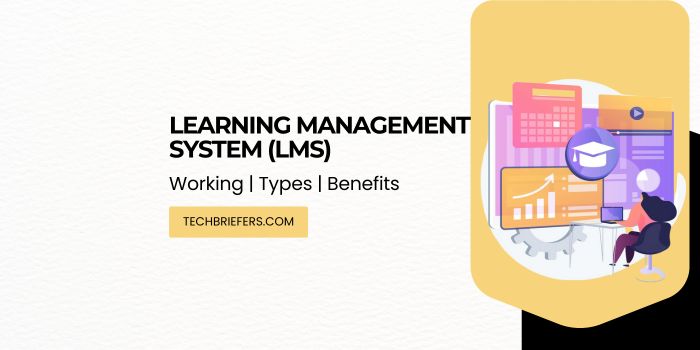LMS/Learning Management System: Working, Types & Benefits

In this online era, teaching and learning have become more flexible thanks to a system called the Learning Management System, often abbreviated as LMS.
This system is like a virtual school that can be accessed anytime and anywhere via our devices. Cool, right? To understand it better, this article will invite you to explore more deeply what an LMS is, its functions, and examples that are popularly used today.
What is an LMS (Learning Management System)?
A Learning Management System is a software application or web-based technology used to plan, implement, and assess specific learning processes.
LMSs are not only used by educational institutions but also by companies to support online learning. LMS allows the creation of learning materials or training courses, taking interactive quizzes, and completing assessments.
Overall, a Learning Management System makes learning more organized, flexible, and accessible anytime, anywhere.
How the Learning Management System Works
A Learning Management System works like a digital storage center that stores all information and learning materials in one place. Every user—whether a student, employee, or instructor—can access the system with a login and password.
If the LMS is hosted on a private server, users may need to install specific software or access it through a company’s server. For example, platforms like Moodle can be installed on a web server for self-hosted use.
However, many modern Learning Management Systems are cloud-based, allowing users to simply open a browser and log in to access a wide variety of learning materials. In this way, data such as course materials, assignments, quizzes, and learning outcomes can be easily accessed anytime and anywhere.
In general, the following features describe how an LMS works:
- Responsive Design: The LMS automatically adapts its appearance to the device in use, whether it’s a laptop, tablet, or mobile phone.
- User-Friendly Interface: A simple and easy-to-use interface ensures users can focus on learning without confusion.
- Reports and Analytics: Provides data on course effectiveness and user performance, helping to evaluate the learning process.
- Course Catalog and Management: Helps administrators manage courses more efficiently, making learning structured and accessible.
- Certification and Compliance Support: Ideal for training that requires certification, with accurate performance tracking and record-keeping.
- Social Learning Capabilities: Includes features that allow collaboration and sharing among users.
- Gamification: Incorporates elements like badges and points to increase motivation and engagement.
- Artificial Intelligence (AI): AI in LMSs helps personalize learning by recommending courses based on user preferences.
Also Read: Can you Learn Programming on your own?
Types of LMS and Examples
LMS platforms come in different types based on hosting models and functionality. Each type offers features that can be tailored to meet an organization’s specific needs, from flexibility in access to the desired level of interaction.
#1 Cloud-Based LMS
Cloud-based LMS platforms are hosted on remote servers, allowing access from anywhere with an internet connection. Organizations prefer this type for its flexibility and lower operational costs, as it eliminates the need for local server infrastructure.
Examples of cloud-based LMS:
- Google Classroom: Widely used in schools and universities for its ease of use and integration with Google tools.
- MoodleCloud: A cloud-hosted version of Moodle, suitable for institutions without their own server infrastructure.
#2 Open Source LMS
Open-source LMS platforms offer access to their source code, enabling developers to customize and adapt the system to specific needs. This option is best for organizations with technical expertise.
Examples of open-source LMS:
- Moodle: Popular in academic and corporate settings due to its flexibility and robust customization options.
- Chamilo: Another widely used open-source LMS, especially in academic institutions.
#3 Gamified LMS
This type of LMS incorporates game elements, such as points, badges, and leaderboards, to enhance learner engagement. It’s ideal for training programs that require high interactivity.
Examples of gamified LMS:
- TalentLMS: Offers gamification features and is widely used for corporate training.
- ClassDojo: Uses points and badges to motivate younger learners, suitable for elementary to middle school education.
#4 Mobile LMS
Designed specifically for mobile and tablet use, mobile LMS platforms allow users to access content on the go. Some even support offline access, ideal for learners in areas with limited connectivity.
Examples of mobile LMS:
- Edmodo: Offers a mobile-friendly experience, helping teachers and students stay connected through mobile devices.
- Canvas Student App: A mobile version of the Canvas LMS, providing full access to learning materials and progress tracking.
Also Read:Online Business Definition | Online Business Types and Benefits
Benefits of Using LMS
An LMS benefits not only instructors, educational institutions, and companies but also learners such as students and employees. Here are some of the advantages of implementing an LMS for learning and training:
For Instructors or Training Managers
- Simplified Training Management and Tracking: Create, assign, and monitor courses in one centralized platform.
- Reduced Training Costs: Eliminates expenses related to physical venues and materials.
- Remote Learning Support: Offers consistent training quality regardless of location.
- Enhanced Engagement: Multimedia features such as videos, quizzes, and audio improve learning outcomes.
- Flexible Access: Available across devices, enabling on-the-go learning.
For Students or Employees
- Time and Location Flexibility: Learn anytime, anywhere—perfect for busy schedules.
- Self-Paced Learning: Revisit and review materials as often as needed.
- Centralized Resources: Easily access course content, notes, and references.
- Progress Tracking: Visual dashboards help learners monitor their advancement.
- Certifications: Many LMS platforms offer certifications that can enhance professional credentials.
Conclusion
So, what is an LMS? A Learning Management System is an essential tool in both education and business. It simplifies the learning process while increasing flexibility and efficiency in managing and delivering training materials.
LMS platforms allow learners to study at their convenience, and instructors to effectively manage content and track progress—all in one place. Whether you’re a student, educator, or corporate trainer, an LMS can be a powerful ally in your learning journey.

Leave a Reply